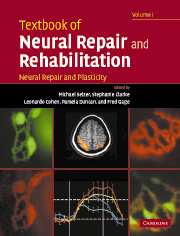Crossref Citations
This Book has been
cited by the following publications. This list is generated based on data provided by Crossref.
Dougall, A.
and
Fiske, J.
2008.
Access to special care dentistry, part 4. Education.
British Dental Journal,
Vol. 205,
Issue. 3,
p.
119.
Di Loreto, Ines
Van Dokkum, Liesjet
Gouaich, Abdelkader
and
Laffont, Isabelle
2011.
Virtual and Mixed Reality - Systems and Applications.
Vol. 6774,
Issue. ,
p.
11.
Cordun, Mariana
and
Marinescu, Gabriela Adriana
2014.
Functional Rehabilitation Strategies for the Improvement of Balance in Patients with Hemiplegia after an Ischemic Stroke.
Procedia - Social and Behavioral Sciences,
Vol. 117,
Issue. ,
p.
575.
Goel, Aimee
2016.
Stem cell therapy in spinal cord injury: Hollow promise or promising science?.
Journal of Craniovertebral Junction and Spine,
Vol. 7,
Issue. 2,
p.
121.
Caramenti, Martina
Bartenbach, Volker
Gasperotti, Lorenza
Oliveira da Fonseca, Lucas
Berger, Theodore W.
and
Pons, José L.
2016.
Emerging Therapies in Neurorehabilitation II.
Vol. 10,
Issue. ,
p.
1.
Palacios-Navarro, Guillermo
and
Hogan, Neville
2021.
Head-Mounted Display-Based Therapies for Adults Post-Stroke: A Systematic Review and Meta-Analysis.
Sensors,
Vol. 21,
Issue. 4,
p.
1111.
BULBOACA, Adriana Elena
STANESCU, Ioana
NICULA, Cristina
and
BULBOACA, Angelo
2021.
Neuroplasticity pathophysiological mechanisms underlying neuro-optometric rehabilitation in ischemic stroke – a brief review.
Balneo and PRM Research Journal,
Vol. 12,
Issue. Vol.12, no.1,
p.
16.
Naro, Antonino
and
Calabrò, Rocco Salvatore
2021.
What Do We Know about The Use of Virtual Reality in the Rehabilitation Field? A Brief Overview.
Electronics,
Vol. 10,
Issue. 9,
p.
1042.
Morizio, Charles
Billot, Maxime
Daviet, Jean-Christophe
Baudry, Stéphane
Barbanchon, Christophe
Compagnat, Maxence
and
Perrochon, Anaick
2021.
Postural Control Disturbances Induced by Virtual Reality in Stroke Patients.
Applied Sciences,
Vol. 11,
Issue. 4,
p.
1510.
Lee, Kyeongbong
Oh, HyeJin
and
Lee, GyuChang
2022.
Fully Immersive Virtual Reality Game-Based Training for an Adolescent with Spastic Diplegic Cerebral Palsy: A Case Report.
Children,
Vol. 9,
Issue. 10,
p.
1512.
Morizio, Charles
Compagnat, Maxence
Boujut, Arnaud
Labbani-Igbida, Ouiddad
Billot, Maxime
and
Perrochon, Anaick
2022.
Immersive Virtual Reality during Robot-Assisted Gait Training: Validation of a New Device in Stroke Rehabilitation.
Medicina,
Vol. 58,
Issue. 12,
p.
1805.
Sim, Tae Yong
and
Kwon, Jae Sung
2022.
Comparing the effectiveness of bimanual and unimanual mirror therapy in unilateral neglect after stroke: A pilot study.
NeuroRehabilitation,
Vol. 50,
Issue. 1,
p.
133.



